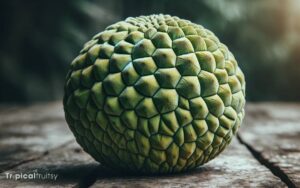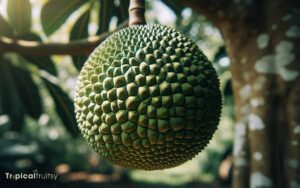Fruit That Looks Like Breadfruit: Unveiling the Mystery!
In the realm of botanical curiosities, fruits bearing resemblance to the tropical breadfruit (Artocarpus altilis) intrigue both the culinary enthusiast and the botanist.
The breadfruit, with its globular shape and distinctive, pitted surface, is often mistaken for other large, starchy fruits. Among these is the jackfruit (Artocarpus heterophyllus), celebrated for its versatility and meat-like texture.
Less known but equally fascinating is the breadnut (Brosimum alicastrum), which provides both fruit and seeds for consumption.
Other similar fruits, such as the Sapodilla (Manilkara zapota), also known as cheeku, add sweetness to this collection.
This introduction serves to navigate the rich diversity of fruits that echo the appearance of breadfruit, aiming to enlighten those who seek to expand their knowledge of tropical botanical offerings and their uses in various cultural cuisines.
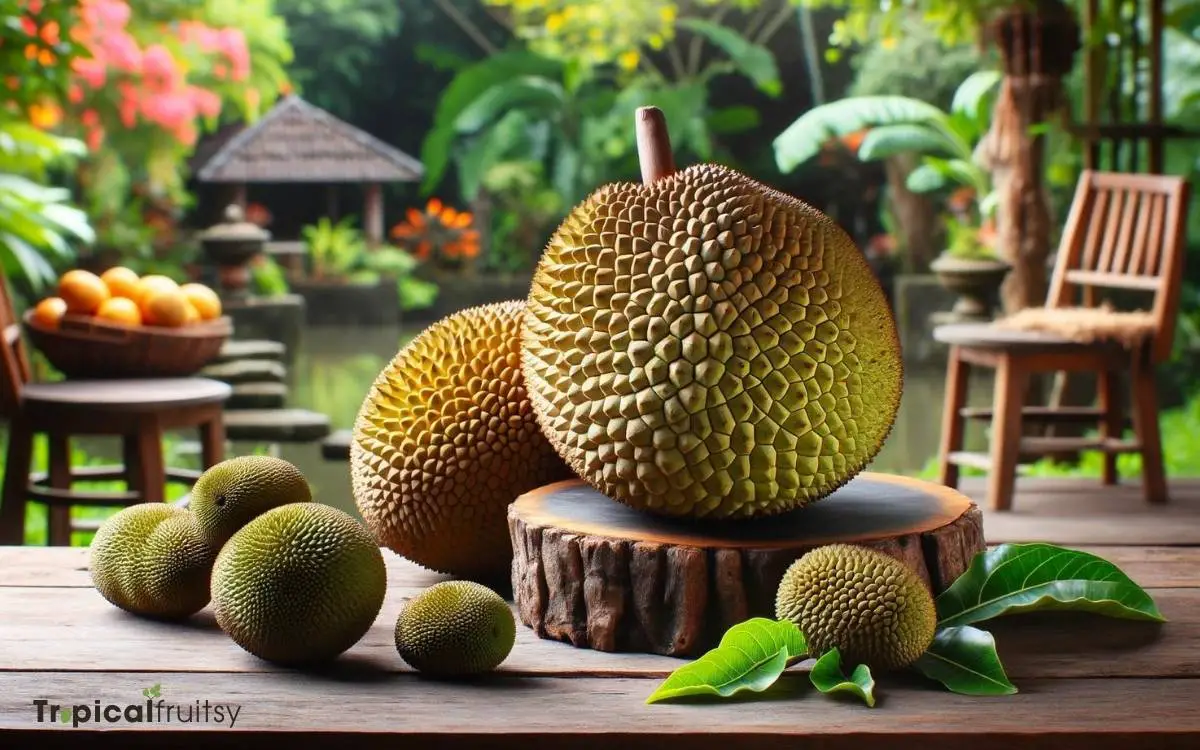
Key Takeaway
The Versatile Jackfruit

One often-confused relative of breadfruit is the jackfruit, a tropical fruit known for its size, distinctive aroma, and flexible culinary applications.
Botanically termed Artocarpus heterophyllus, jackfruit’s morphology is characterized by a spiky, green exterior and fibrous, yellow to orange interior flesh that encapsulates multiple seeds. It is the largest tree-borne fruit, with specimens weighing up to 55 kilograms.
Nutritionally, jackfruit is lauded for its high vitamin C content and dietary fiber. It is a versatile ingredient, eaten raw when ripe, with a flavor profile reminiscent of a combination of apple, pineapple, mango, and banana.
Unripe jackfruit is utilized as a plant-based meat substitute due to its texture, which closely mimics that of pulled pork.
This adaptability in culinary use underscores the fruit’s increasing popularity in various gastronomic cultures. The exploration of jackfruit paves the way for uncovering another related species, the breadnut.
Discovering the Breadnut
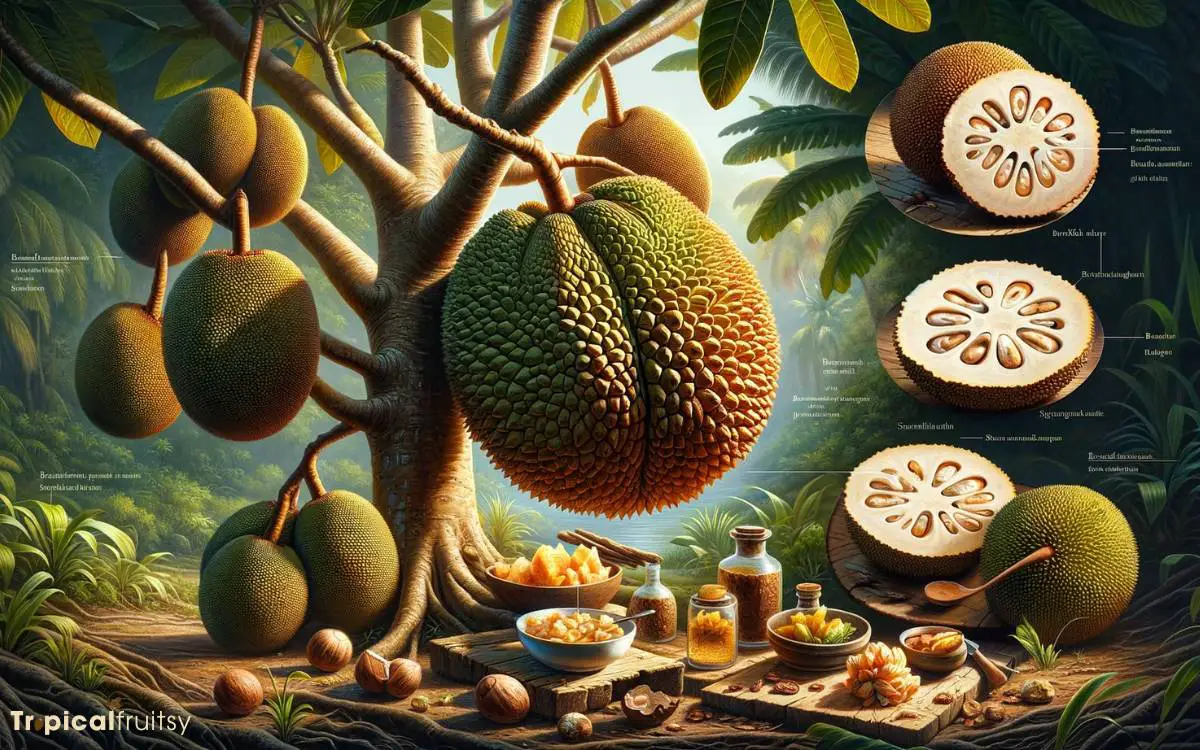
Transitioning from the jackfruit, the breadnut, scientifically known as Artocarpus camansi, presents itself as another intriguing member of the Moraceae family, bearing a close resemblance to breadfruit in appearance and utility.
Indigenous to the New Guinea region, the breadnut has propagated throughout tropical environments, valued for its nutrient-rich seeds.
Unlike the breadfruit, which is commonly consumed for its fleshy starchy pulp, the breadnut’s primary culinary contribution lies within its seeds.
These seeds are a substantial source of protein and can be prepared in a variety of methods, including boiling, roasting, or grounding into flour.
The breadnut’s adaptability to diverse agroforestry systems underscores its potential in food security endeavors, particularly in regions afflicted by climate variability and economic constraints.
Cheeku: Sapodilla’s Charm
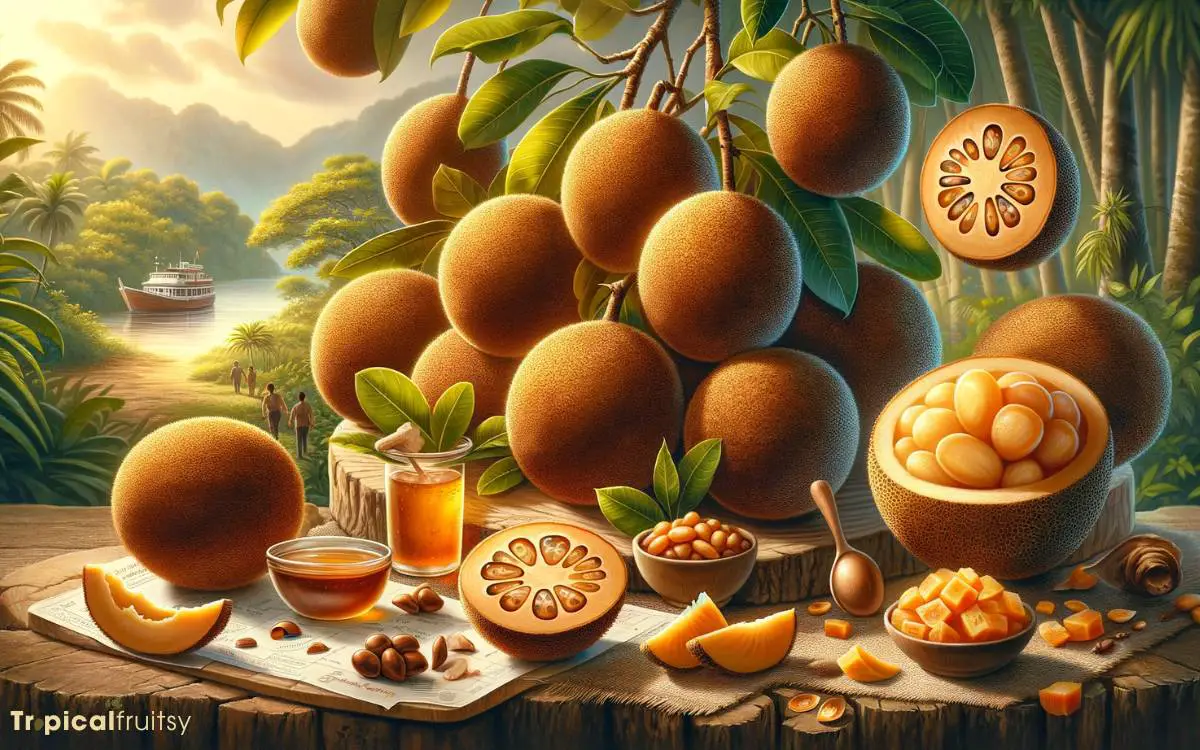
Sapodilla, known regionally as Cheeku, bears a modest exterior, yet its sweet, granular flesh distinguishes it as a unique fruit often compared to the texture of a pear.
Originating from the rainforests in Central America, Sapodilla (Manilkara zapota) is a tropical fruit, rich in vitamins, minerals, and dietary fiber.
Its taste profile is an intricate blend of sweetness with a malty undertone, making it a favored ingredient in desserts and beverages.
Botanically, the sapodilla tree contributes significantly to its habitat, providing a sustainable source of latex and timber. Agriculturally, it is cultivated in various tropical regions, adapting well to a range of soils.
Its resilience against wind and drought conditions makes it an ecologically robust species, enhancing its appeal to cultivators and consumers alike.
The Unique Osage Orange
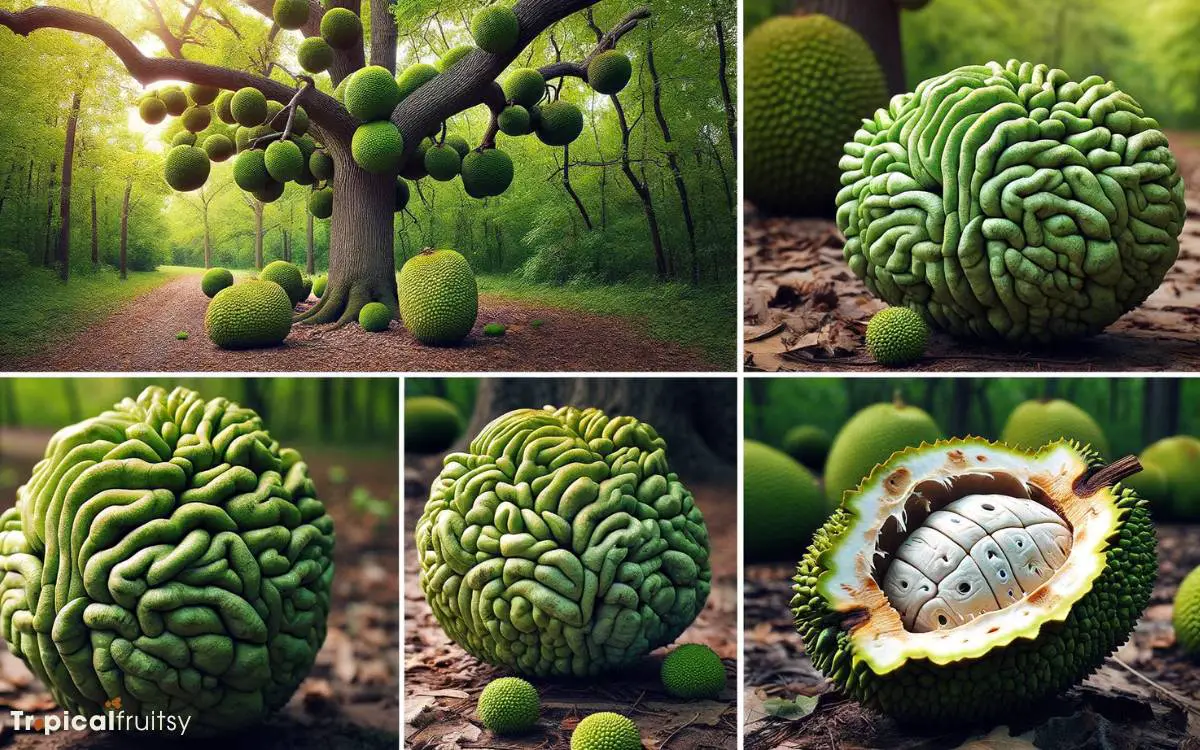
The Osage orange is distinguished by its convoluted, bumpy exterior. It presents a curious case in the pantheon of fruit morphology and has often been mistaken for breadfruit due to its superficial resemblance.
Although it is generally deemed inedible, the fruit has found application in various non-culinary uses, which underscores its utilitarian value beyond mere aesthetics.
Its significance to Native American cultures, particularly the Osage Nation, is embedded in historical usage that influenced the naming and distribution patterns of this unique botanical specimen.
Distinctive Bumpy Exterior
Another fruit with a bumpy exterior that is often mistaken for breadfruit is the Osage orange, known for its textured, green surface.
This unique fruit is not only distinctive in its appearance but also in its botanical characteristics and ecological significance.
Morphological Traits:
- Multiple compound drupes form the large, globular structure.
- The bumpy texture is due to the fruit’s numerous and tightly packed ovaries.
- Ecological Role:
- Historically, the wood of the Osage orange tree was prized by Native Americans for bow-making.
- The fruit serves as a deterrent to natural herbivores due to its latex-rich, milky juice and hard, inedible flesh.
An understanding of the Osage orange’s unique morphology and its ecological adaptations can enhance the appreciation of its role in biodiversity and cultural history.
Inedible Fruit Uses
Despite its inedibility to humans, the Osage orange fruit has found various utilitarian applications, including natural insect repellent properties and decorative elements due to its unique appearance.
Scientific analysis reveals that compounds within the fruit, particularly tetrahydroxystilbene, are responsible for the repulsion of certain insects. This bioactive constituent suggests the potential for Osage orange derivatives in pest control strategies.
| Property | Detail | Implication |
|---|---|---|
| Insect Repellency | Emits a repelling scent | Natural pesticide alternative |
| Aesthetic Appeal | Textured, green spherical shape | Utilized in ornamental displays |
| Hardiness | Dense wood | Employed in crafting and fencing |
The fruit’s dense wood also provides a robust material for traditional crafting and fencing, signifying a multifaceted resource beyond its primary biological function.
Understanding the full spectrum of the Osage orange’s applications underscores the value of inedible fruits in various non-consumptive roles.
Native American Significance
While the Osage orange is known for its inedible fruit and practical uses, its significance to Native American tribes extends beyond its physical attributes, serving as a vital component in their cultural heritage and daily living.
Cultural Significance:
- Symbolic Value: The tree was often associated with peace and protection in native lore.
- Ceremonial Uses: Parts of the tree were used in tribal rituals and ceremonies, underscoring its spiritual importance.
Practical Applications:
- Crafting Material: The strong, flexible wood of the Osage orange tree was prized for making bows and other tools.
- Natural Barrier: The dense thicket it forms was employed as a protective hedge, effectively marking territory boundaries and deterring wildlife.
In this context, the Osage orange was not merely a plant with peculiar fruit but a fundamental resource intricately woven into the fabric of Native American life.
Pondering the Pandanus Fruit

Although often mistaken for breadfruit due to its similar appearance, the pandanus fruit is a distinct species with unique characteristics and culinary uses.
Unlike the breadfruit, the pandanus, or screw pine, possesses a segmented growth pattern and its fruit is comprised of multiple keys or cones.
These keys contain a fibrous, edible interior that, once processed, is incorporated into various culinary traditions.
The pandanus fruit is also noted for its aromatic leaves, which are widely used as a flavoring agent across Southeast Asian cuisines.
| Pandanus Fruit | Breadfruit |
|---|---|
| Segmented growth | Globular shape |
| Multiple keys/cones | Single, large fruit |
| Aromatic leaves used | Starchy texture |
As we dissect the pandanus fruit’s attributes, we gain insight into its role within cultural gastronomy. This level of understanding serves as a precursor to unraveling the durian mystery, another tropical fruit with a complex profile.
Unraveling the Durian Mystery

Delving into the realm of tropical fruits, we encounter the durian, often confused with breadfruit due to its formidable size and spiky exterior, yet it is renowned for its pungent aroma and distinctive taste.
This enigmatic fruit has captivated and divided palates worldwide.
Aroma and Flavor Profile
- Sulfur Compounds: Account for its unique, potent smell, likened to rotten onions or raw sewage.
- Rich Custard-like Texture: Offers a complex flavor combination, with hints of almond and a sweet, buttery taste that contrasts its odor.
Cultivation and Varieties
- Selective Breeding: Efforts to reduce odor intensity without compromising taste are ongoing.
- Regional Preferences: Specific varieties, such as Musang King, are highly sought after for their superior quality.
Informed analysis of durian’s sensory attributes and cultivation nuances reveals why this fruit remains a subject of intense curiosity and cultural significance.
The Deceptive Kwai Muk
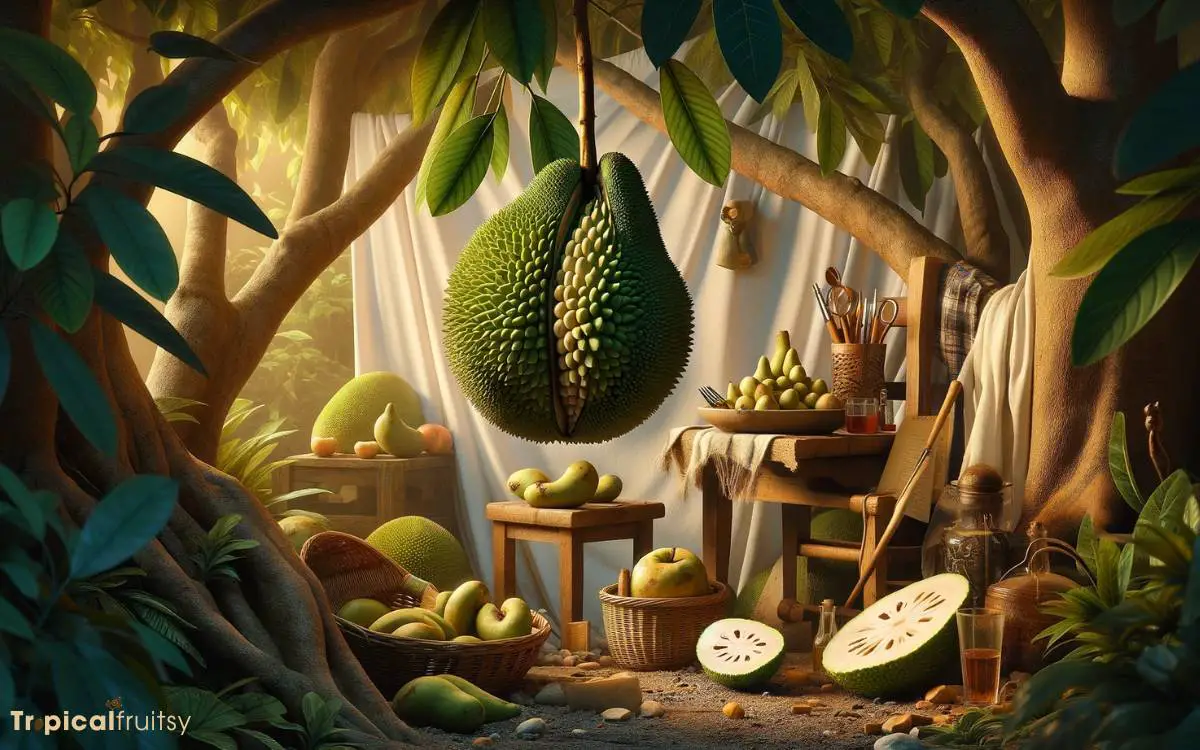
The Kwai Muk (Artocarpus hypargyreus) is a fruit that bears a visual resemblance to the breadfruit. However, it exhibits a distinct set of botanical characteristics that facilitate its identification.
Its flavor profile is complex, often described as a nuanced blend of acidity and sweetness, which sets it apart from its more starchy counterpart.
In culinary contexts, Kwai Muk is less recognized than breadfruit. However, it offers a versatile range of applications, from fresh consumption to incorporation in various cooked dishes.
Kwai Muk Identification
Kwai Muk, a fruit resembling breadfruit, is scientifically known as Artocarpus hypargyreus and can be identified by its distinctive small size and bumpy skin.
This subtropical species is often mistaken for its larger relative due to its morphological characteristics.
However, upon closer inspection, several key features distinguish Kwai Muk:
Morphological Traits:
- Size: Typically ranges from 2.5 to 7.5 cm in diameter.
- Skin Texture: Exhibits a rough, uneven surface with a leathery touch.
Sensory Attributes:
- Color: The skin may present a yellow to orange hue when ripe.
- Flavor Profile: Offers a subtly sweet taste with a hint of acidity, unlike the bland taste of breadfruit.
Understanding these nuances ensures accurate identification and appreciation of Kwai Muk in botanical and culinary contexts.
Flavor Profile
Artocarpus hypargyreus, commonly known as Kwai Muk, offers a unique flavor profile that combines a subtle sweetness with a tangy acidity, setting it apart from the neutral taste of breadfruit.
Upon analytical examination, the Kwai Muk’s organoleptic characteristics reveal a complex interplay of flavor compounds. The fruit’s sweetness largely derives from its fructose content, which can vary depending on ripeness.
The acidity can be attributed to the presence of organic acids such as citric and malic acid, which confer a refreshing zestiness.
Connoisseurs appreciate its multifaceted taste, which may also exhibit hints of berry-like flavors, contributing to its gastronomic versatility.
The deceptive Kwai Muk thus challenges the palate with its intricate taste dimensions that are not immediately discernible from its breadfruit-like appearance.
Culinary Uses
Delving into the culinary realm, Kwai Muk’s deceptive appearance belies its utility in a variety of dishes, ranging from sweet desserts to savory concoctions.
The fruit’s adaptability is underscored by its textural firmness when unripe and its jam-like consistency once matured.
This transformation allows for a diverse spectrum of culinary applications, which can be analytically categorized as follows:
Sweet Applications:
- Dessert Syrups: Ripe Kwai Muk can be reduced into a thick syrup, enhancing the flavors of ice creams and pastries.
- Fruit Compotes: Its slightly acidic taste complements richer dessert bases, providing a balance of flavors.
Savory Pairings:
- Chutneys and Relishes: The fruit’s firmness when unripe is ideal for creating textured condiments.
- Flavor Enhancer: Kwai Muk adds a subtle, fruity undertone to marinades and sauces, enriching the overall savoriness.
Is the Fruit That Looks Like Breadfruit Edible?
Yes, what does breadfruit look like? The fruit resembling breadfruit is known as jackfruit. It is a tropical fruit with a spiky green exterior and sweet, yellow flesh inside. Jackfruit is indeed edible, commonly used in vegetarian and vegan dishes as a meat substitute due to its texture.
Exploring the Morinda Citrifolia
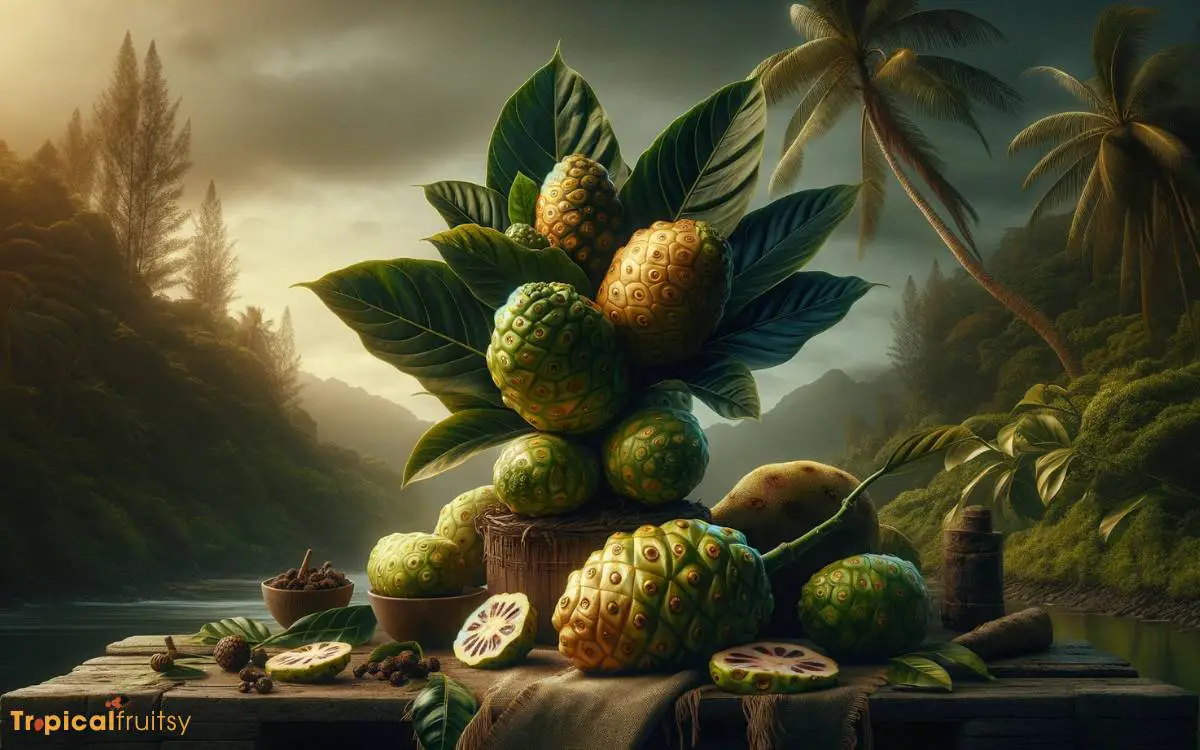
One species that shares a visual resemblance with breadfruit is Morinda citrifolia, commonly known as noni.
This tropical fruit-bearing tree belongs to the coffee family, Rubiaceae, and is notable for its distinctive, pungent odor and rugged surface.
Noni has a complex phytochemical profile, with an array of iridoids, flavonoids, fatty acids, and coumarins. These compounds are the focus of scientific scrutiny for their potential therapeutic properties.
The fruit’s primary iridoid, deacetylasperulosidic acid, has been linked to various biological activities, including antioxidant and anti-inflammatory effects.
Analytical studies emphasize noni’s ethnopharmacological relevance, where it is used in traditional medicine across different cultures, particularly in Polynesia.
Understanding Morinda citrifolia’s bioactive constituents continues to be a significant endeavor to substantiate its ethnobotanical uses with empirical evidence.
Conclusion
In the intricate tapestry of flora, fruits masquerading as the humble breadfruit emerge as marvels of nature’s ingenuity.
From the jackfruit’s majestic versatility to the sapodilla’s understated allure, each bears the imprint of botanical brilliance.
The enigmatic durian, the misunderstood kwai muk, and the exotic morinda citrifolia weave a narrative of diversity and complexity.
As custodians of this ecological wealth, humanity must endeavor to appreciate and preserve the rich cornucopia bestowed by the natural world.

